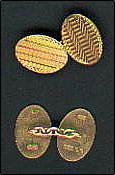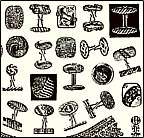The Evolution of Cuff Links
 |
| Gold cuff links circa early 1900's |
Over time, cuff links developed from being purely practical to reflecting the fashionable design influences of the period, suggests Eugene Klompus.
Necessity is the mother of invention! Thus cuff links evolved from primitive fasteners that our cave-dwelling ancestors used to hold their animal skin garment sleeves at the wrist; hieroglyphics confirms the use of vines, twigs and animal sinew as fastening ties for this purpose. The earliest cuff links were strictly functional devices.
The first recorded use of cuff links as an item of adornment dates back to the 14th century B.C. and the dynasty of Egypt's King Tutenkhamen. Among the articles found in "Tut's" tomb were colorful pieces of jewelry which were unmistakably used for fastening and adorning the King's vestment cuffs.
Today's cuff links can be easily traced to those worn by the royalty and noblemen of 17th century Europe. Wealth was often measured by the size, shape and weight of the precious metals and gemstones in the wearer's cuff links, rings and other jewelry. Indeed, the cuff fasteners of this period were a literal palette for a King's goldsmith.
Though the couturiers of both France and England claimed to have invented the concept of the cuff slits through which the links are inserted, the survival of the name, "French Cuff" suggests that the dispute was won by France.
The invention of synthetic shiny metals and sparkling stones in the mid-1700s enabled lesser ranking subjects to imitate the glitter and elegance of their superiors. By the early 1800s, the Industrial Revolution's mass production capability fostered the availability and affordability of cuff links for even the working classes.
 |
| Victorian cuff links |
Cuff links have always mirrored the art and fashion of their times. For example, the various phases of the Victorian period (1840-1900), including its accent on classicism, romanticism, detail and the ostentatious, had a heavy influence on that era's cuff link design and use. Many of the Victorian touches such as filigree, preference for figural dimension and innovative shape are still popular in today's cuff link designs. Likewise, motifs from the Art Deco period are still very evident in modern cuff link design. Cuff links continue to be a timeless item of both function and elegant fashion.
Eugene R. Klompus is president of the National Cuff Link Society
Copyright, ©2001
Recommended reading on the subject includes:
Cuff Links by Susan Jonas and Marilyn Nissenson, 199 illustrations, 186 in colour, 112 pp., softcover.
To purchase this or any other books about cuff links, you can order online